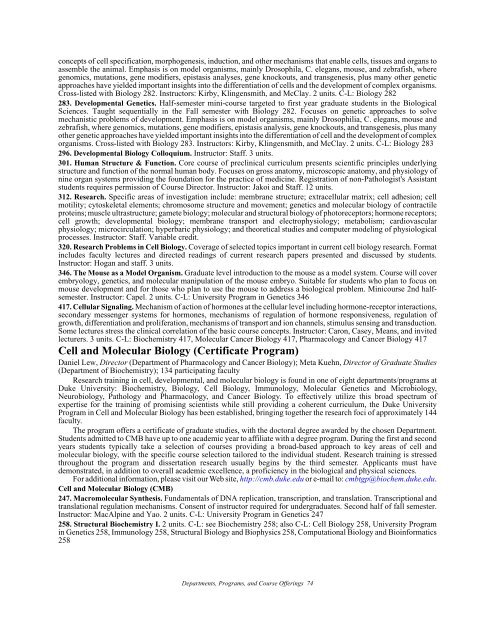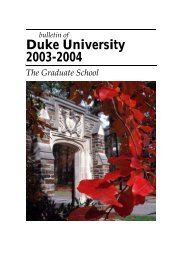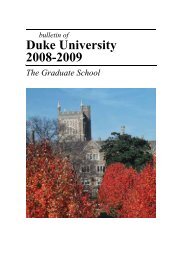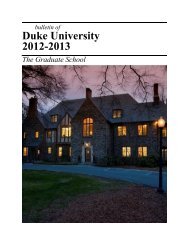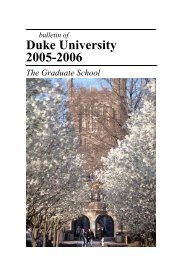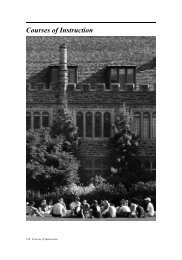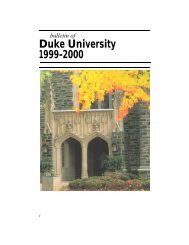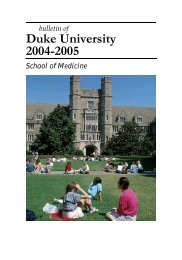Duke University 2009-2010 - Office of the Registrar - Duke University
Duke University 2009-2010 - Office of the Registrar - Duke University
Duke University 2009-2010 - Office of the Registrar - Duke University
Create successful ePaper yourself
Turn your PDF publications into a flip-book with our unique Google optimized e-Paper software.
concepts <strong>of</strong> cell specification, morphogenesis, induction, and o<strong>the</strong>r mechanisms that enable cells, tissues and organs to<br />
assemble <strong>the</strong> animal. Emphasis is on model organisms, mainly Drosophila, C. elegans, mouse, and zebrafish, where<br />
genomics, mutations, gene modifiers, epistasis analyses, gene knockouts, and transgenesis, plus many o<strong>the</strong>r genetic<br />
approaches have yielded important insights into <strong>the</strong> differentiation <strong>of</strong> cells and <strong>the</strong> development <strong>of</strong> complex organisms.<br />
Cross-listed with Biology 282. Instructors: Kirby, Klingensmith, and McClay. 2 units. C-L: Biology 282<br />
283. Developmental Genetics. Half-semester mini-course targeted to first year graduate students in <strong>the</strong> Biological<br />
Sciences. Taught sequentially in <strong>the</strong> Fall semester with Biology 282. Focuses on genetic approaches to solve<br />
mechanistic problems <strong>of</strong> development. Emphasis is on model organisms, mainly Drosophilia, C. elegans, mouse and<br />
zebrafish, where genomics, mutations, gene modifiers, epistasis analysis, gene knockouts, and transgenesis, plus many<br />
o<strong>the</strong>r genetic approaches have yielded important insights into <strong>the</strong> differentiation <strong>of</strong> cell and <strong>the</strong> development <strong>of</strong> complex<br />
organisms. Cross-listed with Biology 283. Instructors: Kirby, Klingensmith, and McClay. 2 units. C-L: Biology 283<br />
296. Developmental Biology Colloquium. Instructor: Staff. 3 units.<br />
301. Human Structure & Function. Core course <strong>of</strong> preclinical curriculum presents scientific principles underlying<br />
structure and function <strong>of</strong> <strong>the</strong> normal human body. Focuses on gross anatomy, microscopic anatomy, and physiology <strong>of</strong><br />
nine organ systems providing <strong>the</strong> foundation for <strong>the</strong> practice <strong>of</strong> medicine. Registration <strong>of</strong> non-Pathologist's Assistant<br />
students requires permission <strong>of</strong> Course Director. Instructor: Jakoi and Staff. 12 units.<br />
312. Research. Specific areas <strong>of</strong> investigation include: membrane structure; extracellular matrix; cell adhesion; cell<br />
motility; cytoskeletal elements; chromosome structure and movement; genetics and molecular biology <strong>of</strong> contractile<br />
proteins; muscle ultrastructure; gamete biology; molecular and structural biology <strong>of</strong> photoreceptors; hormone receptors;<br />
cell growth; developmental biology; membrane transport and electrophysiology; metabolism; cardiovascular<br />
physiology; microcirculation; hyperbaric physiology; and <strong>the</strong>oretical studies and computer modeling <strong>of</strong> physiological<br />
processes. Instructor: Staff. Variable credit.<br />
320. Research Problems in Cell Biology. Coverage <strong>of</strong> selected topics important in current cell biology research. Format<br />
includes faculty lectures and directed readings <strong>of</strong> current research papers presented and discussed by students.<br />
Instructor: Hogan and staff. 3 units.<br />
346. The Mouse as a Model Organism. Graduate level introduction to <strong>the</strong> mouse as a model system. Course will cover<br />
embryology, genetics, and molecular manipulation <strong>of</strong> <strong>the</strong> mouse embryo. Suitable for students who plan to focus on<br />
mouse development and for those who plan to use <strong>the</strong> mouse to address a biological problem. Minicourse 2nd halfsemester.<br />
Instructor: Capel. 2 units. C-L: <strong>University</strong> Program in Genetics 346<br />
417. Cellular Signaling. Mechanism <strong>of</strong> action <strong>of</strong> hormones at <strong>the</strong> cellular level including hormone-receptor interactions,<br />
secondary messenger systems for hormones, mechanisms <strong>of</strong> regulation <strong>of</strong> hormone responsiveness, regulation <strong>of</strong><br />
growth, differentiation and proliferation, mechanisms <strong>of</strong> transport and ion channels, stimulus sensing and transduction.<br />
Some lectures stress <strong>the</strong> clinical correlation <strong>of</strong> <strong>the</strong> basic course concepts. Instructor: Caron, Casey, Means, and invited<br />
lecturers. 3 units. C-L: Biochemistry 417, Molecular Cancer Biology 417, Pharmacology and Cancer Biology 417<br />
Cell and Molecular Biology (Certificate Program)<br />
Daniel Lew, Director (Department <strong>of</strong> Pharmacology and Cancer Biology); Meta Kuehn, Director <strong>of</strong> Graduate Studies<br />
(Department <strong>of</strong> Biochemistry); 134 participating faculty<br />
Research training in cell, developmental, and molecular biology is found in one <strong>of</strong> eight departments/programs at<br />
<strong>Duke</strong> <strong>University</strong>: Biochemistry, Biology, Cell Biology, Immunology, Molecular Genetics and Microbiology,<br />
Neurobiology, Pathology and Pharmacology, and Cancer Biology. To effectively utilize this broad spectrum <strong>of</strong><br />
expertise for <strong>the</strong> training <strong>of</strong> promising scientists while still providing a coherent curriculum, <strong>the</strong> <strong>Duke</strong> <strong>University</strong><br />
Program in Cell and Molecular Biology has been established, bringing toge<strong>the</strong>r <strong>the</strong> research foci <strong>of</strong> approximately 144<br />
faculty.<br />
The program <strong>of</strong>fers a certificate <strong>of</strong> graduate studies, with <strong>the</strong> doctoral degree awarded by <strong>the</strong> chosen Department.<br />
Students admitted to CMB have up to one academic year to affiliate with a degree program. During <strong>the</strong> first and second<br />
years students typically take a selection <strong>of</strong> courses providing a broad-based approach to key areas <strong>of</strong> cell and<br />
molecular biology, with <strong>the</strong> specific course selection tailored to <strong>the</strong> individual student. Research training is stressed<br />
throughout <strong>the</strong> program and dissertation research usually begins by <strong>the</strong> third semester. Applicants must have<br />
demonstrated, in addition to overall academic excellence, a pr<strong>of</strong>iciency in <strong>the</strong> biological and physical sciences.<br />
For additional information, please visit our Web site, http://cmb.duke.edu or e-mail to: cmbtgp@biochem.duke.edu.<br />
Cell and Molecular Biology (CMB)<br />
247. Macromolecular Syn<strong>the</strong>sis. Fundamentals <strong>of</strong> DNA replication, transcription, and translation. Transcriptional and<br />
translational regulation mechanisms. Consent <strong>of</strong> instructor required for undergraduates. Second half <strong>of</strong> fall semester.<br />
Instructor: MacAlpine and Yao. 2 units. C-L: <strong>University</strong> Program in Genetics 247<br />
258. Structural Biochemistry I. 2 units. C-L: see Biochemistry 258; also C-L: Cell Biology 258, <strong>University</strong> Program<br />
in Genetics 258, Immunology 258, Structural Biology and Biophysics 258, Computational Biology and Bioinformatics<br />
258<br />
Departments, Programs, and Course Offerings 74


